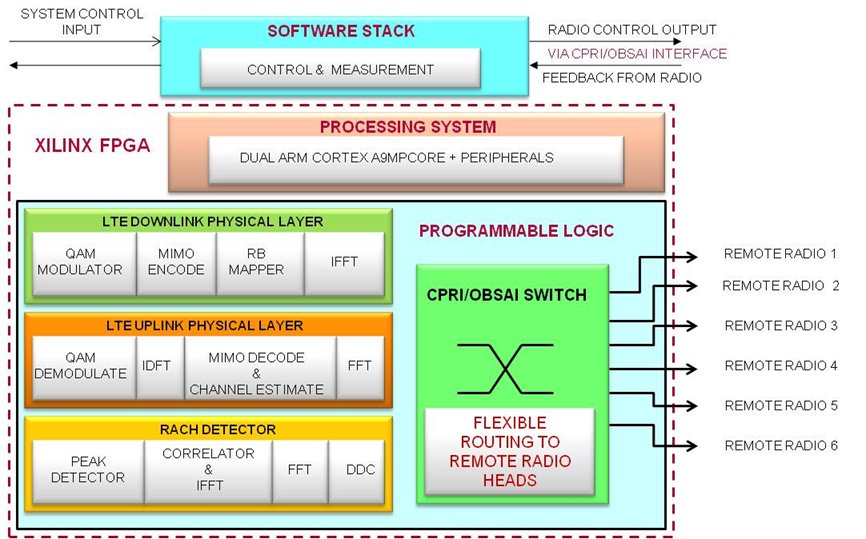Here’s another guest article for Mobile Europe, this time from Harpinder Matharu, Senior Product Manager of Wireless, Xilinx. Matharu’s article examines the potential for building intelligent networks through the use of FPGAs. Naturally, this is an area that Xilinx has a strong interest in, being a designer of FPGAs, but I don’t think we should discount the information in this article all the same. Do FPGA’s offer a route to more cost-effective network upgrades nd intelligence? Marathu, of course, thinks so. See what you think.
Building Intelligence into Mobile Networks with FPGAs
The demand for the ability to access the internet while on the move will increase mobile broadband data growth by a thousand fold in the next ten years. Mobile networks today account for roughly 20% of the world’s annual investment in theglobal communications infrastructure. But that capital spend on mobile networks increases as network operators gear up to meet exponential growth in broadband wireless data.
This rapid growth in demand for data services comes with a daunting set of challenges.
 Firstly, the broadband spectrum available to the wireless infrastructure market today is not sufficient to accommodate the demand for network bandwidth. Secondly, the Capex and Opex associated with rapid mobile network build far exceeds the declining average revenue per unit. To stay competitive and be able to offer Internet-on-the-go means companies have no choice but to upgrade their networks. Thus, building and leveraging network intelligence to offer value added services to lift sagging ARPU and reduce total cost of ownership are two important changes that need to occur to make the business case viable.
Firstly, the broadband spectrum available to the wireless infrastructure market today is not sufficient to accommodate the demand for network bandwidth. Secondly, the Capex and Opex associated with rapid mobile network build far exceeds the declining average revenue per unit. To stay competitive and be able to offer Internet-on-the-go means companies have no choice but to upgrade their networks. Thus, building and leveraging network intelligence to offer value added services to lift sagging ARPU and reduce total cost of ownership are two important changes that need to occur to make the business case viable.
Designing in flexibility
The level of intelligence built into the network depends heavily on how data traffic information is captured by each node in the network and how it is shared throughout the network. This is complicated by the fact that attributes and characteristics of network information will likely change as networks, services, and standards evolve. Also, the total cost of ownership (TCO) reduction is not just a function of cost of the constituent bill of materials(BOM) but also depends on architectural and algorithmic enhancements to improve network utilisation, power consumption, and cost of running and maintaining the networks. All these uncertainties mean that network equipment must be flexible and extensible to make room for continuous algorithmic enhancements to be incorporated throughout the lifetime of installed network equipment and hopefully extend the lifetime of that equipment.
Field Programmable Gate Array (FPGA) devices come to the rescue in solving the above challenges.
 FPGAs allow designers to add intelligence, flexibility, and extensibility into the hardware functions within network entities that can be changed and upgraded in the field as and when algorithm enhancements occur. FPGAs are programmable semiconductor devices that have matrix of configurable logic blocks connected by programmable interconnect. Today, FPGA devices are used in base station and microwave backhaul equipment to implement highly parallel and complex digital signal processing or logic algorithms such as radio digital front end and baseband physical layer– specificallyforward error correctionand complex MIMO encoder/ decoder functions where latency is at premium. Companies are also using FPGAs for packet processing and traffic management functions in the backhaul networks.
FPGAs allow designers to add intelligence, flexibility, and extensibility into the hardware functions within network entities that can be changed and upgraded in the field as and when algorithm enhancements occur. FPGAs are programmable semiconductor devices that have matrix of configurable logic blocks connected by programmable interconnect. Today, FPGA devices are used in base station and microwave backhaul equipment to implement highly parallel and complex digital signal processing or logic algorithms such as radio digital front end and baseband physical layer– specificallyforward error correctionand complex MIMO encoder/ decoder functions where latency is at premium. Companies are also using FPGAs for packet processing and traffic management functions in the backhaul networks.
FPGA technologyhas fast evolved over the last ten years from implementing board logic functions to ASIC/ASSP prototyping to replacing ASIC/ASSP devices for complex algorithmic functions. In the last few years, the majority of base station designs have used FPGAs for prototyping and during initial product shipments, replacing some of the FPGAs in the design with ASIC devices as volumes ramped up and products matured. Today, FPGAs have become cost effective alternatives to ASIC implementations by quickly adopting 40nm and 28nm process geometries for performance, power, and cost improvements. And as network equipment providers face growth in demand for bandwidth in the face of changing requirements and stands, it isn’t likely that companies are going to return to ASICs, which are complex, inflexible, expensive, and ultimately too risky to build.
Minimising field upgrade expenses
The benefit of underlying programmable hardware in base stations is evident in the rollout of UMTS high speed packet access (HSPA) technologyover the last three years.
HSPA equipment started with 7.2 Mbps data rates. Currently, these products are being updated to 21 Mbps systems (10 codes, 16 QAM adaptive modulation coding) or 28 Mbps systems (15 codes, 64 QAM adaptive modulation coding). While LTE base stations arebeginning to roll out, many operators are planning on extending their HSPA network by supporting 42 Mbps using MIMO and 84 Mbps by using multiple carriers.
While not all updates could be carried out without hardware change,base station designs using programmable hardware platforms could have minimised the hardware changes. This is a key learning stage for LTE installations in light of the fact that technological advances in spectrum utilisation, power conservation, and network management are expected to happen at a much more rapid pace. Indeed, it appears that not using programmable hardware in LTE base stations may turn out to be much more expensive over a long run.
Continuous algorithmic enhancements in base station
Mobile network equipment vendors can leverage FPGA devices to embed programmability into their equipment offerings to boost intelligence and spectrum utilisation. With FPGAs, they can update both software and hardware asnew algorithms become available without having to changegear they’ve already installed at customer sites.
The MIMO algorithms in baseband physical layer processing are instrumental in improving spectral efficiency. These algorithms are expected to evolve over time to bring further improvements in efficiencies. An FPGA has more than adequate DSP performance to host these complex algorithms. Companies can easily update these hardware algorithm designs by transferring a new bit stream remotely to a flash device connected to anFPGA. Likewise, they can also use the FPGAs to enhance digital pre-distortion (DPD) algorithmsdeployed in radio to improving power amplifier efficiencies. These systems often require ongoing tweaking and refinement, which makes FPGAs even more suitable.
Network intelligence in the backhaul
Companies are also widely building intelligence into backhaul equipment using FPGAs, which performdeep packet inspection and traffic management at wire-speed to enforce fine grain service and application level agreements, content based billing and network optimisation. Today, FPGA vendors also offer devices that include microprocessors built into the ICs alongside FPGA logic fabric. These FPGAs with integrated processors improve the capability of processing packets and extracting information for network intelligenceat wire speed. The devices facilitate a close coupling between programmable hardware and software thatamplifies performance gains by minimizing the need for packet data transfers to/ from external memory as the data is being processed.
FPGA based programmable platforms within Mobile networks provide essential underlying hardware functions to help contain runaway Capex and Opex associated with network upgrade and maintenance,whilst enabling innovation of new services by tapping value and intelligence within networks to help resurrect healthy revenue returns.
For further information, visit www.xilinx.com.



 Firstly, the broadband spectrum available to the wireless infrastructure market today is not sufficient to accommodate the demand for network bandwidth. Secondly, the Capex and Opex associated with rapid mobile network build far exceeds the declining average revenue per unit. To stay competitive and be able to offer Internet-on-the-go means companies have no choice but to upgrade their networks. Thus, building and leveraging network intelligence to offer value added services to lift sagging ARPU and reduce total cost of ownership are two important changes that need to occur to make the business case viable.
Firstly, the broadband spectrum available to the wireless infrastructure market today is not sufficient to accommodate the demand for network bandwidth. Secondly, the Capex and Opex associated with rapid mobile network build far exceeds the declining average revenue per unit. To stay competitive and be able to offer Internet-on-the-go means companies have no choice but to upgrade their networks. Thus, building and leveraging network intelligence to offer value added services to lift sagging ARPU and reduce total cost of ownership are two important changes that need to occur to make the business case viable. FPGAs allow designers to add intelligence, flexibility, and extensibility into the hardware functions within network entities that can be changed and upgraded in the field as and when algorithm enhancements occur. FPGAs are programmable semiconductor devices that have matrix of configurable logic blocks connected by programmable interconnect. Today, FPGA devices are used in base station and microwave backhaul equipment to implement highly parallel and complex digital signal processing or logic algorithms such as radio digital front end and baseband physical layer– specificallyforward error correctionand complex MIMO encoder/ decoder functions where latency is at premium. Companies are also using FPGAs for packet processing and traffic management functions in the backhaul networks.
FPGAs allow designers to add intelligence, flexibility, and extensibility into the hardware functions within network entities that can be changed and upgraded in the field as and when algorithm enhancements occur. FPGAs are programmable semiconductor devices that have matrix of configurable logic blocks connected by programmable interconnect. Today, FPGA devices are used in base station and microwave backhaul equipment to implement highly parallel and complex digital signal processing or logic algorithms such as radio digital front end and baseband physical layer– specificallyforward error correctionand complex MIMO encoder/ decoder functions where latency is at premium. Companies are also using FPGAs for packet processing and traffic management functions in the backhaul networks.